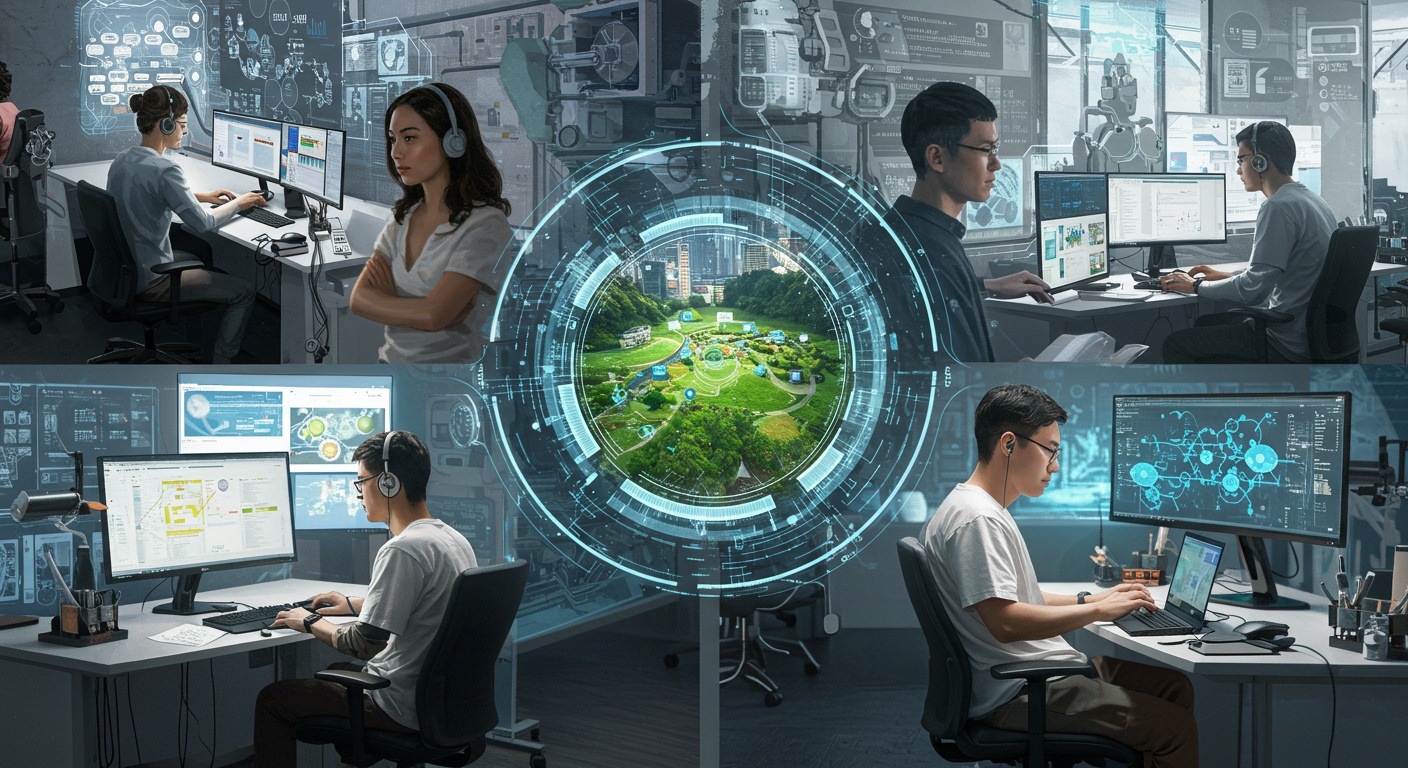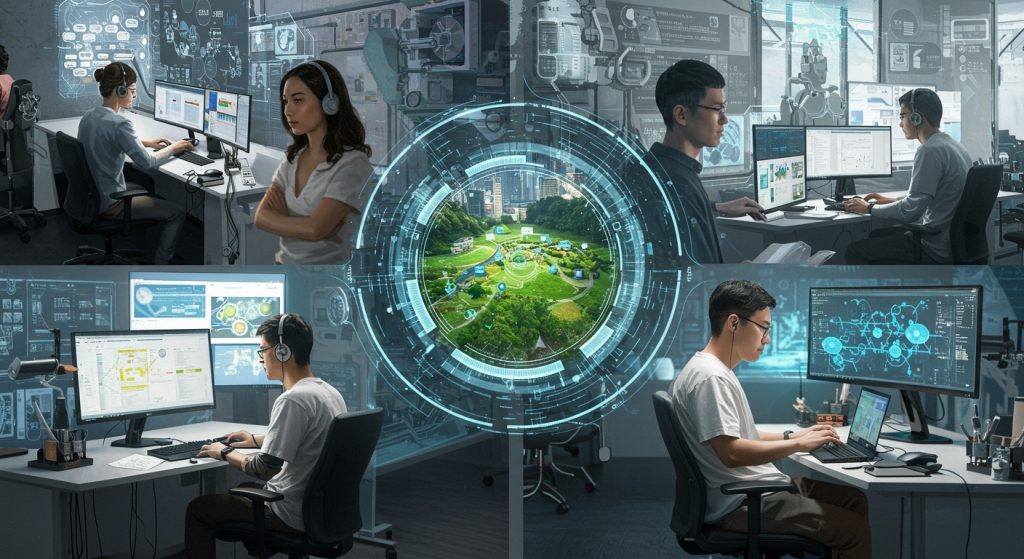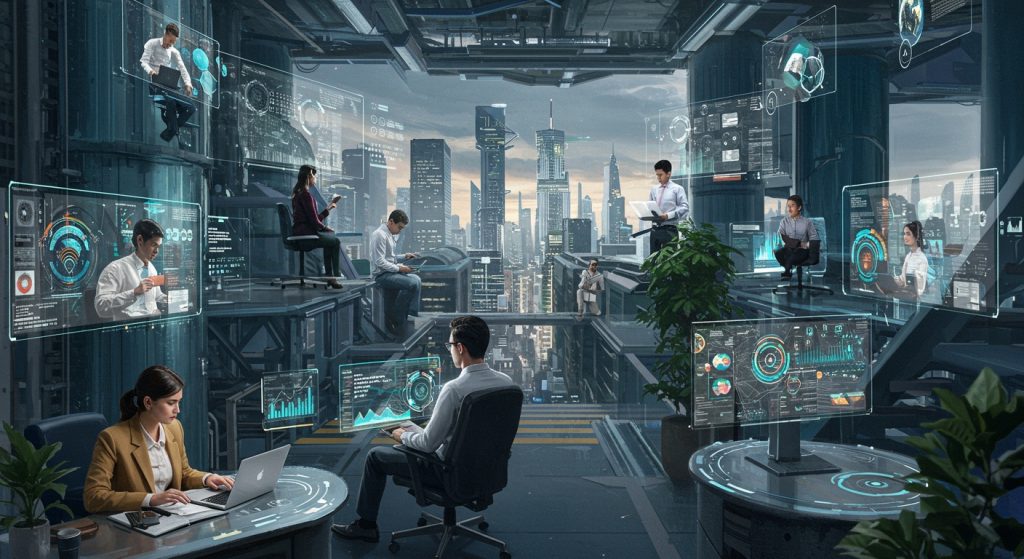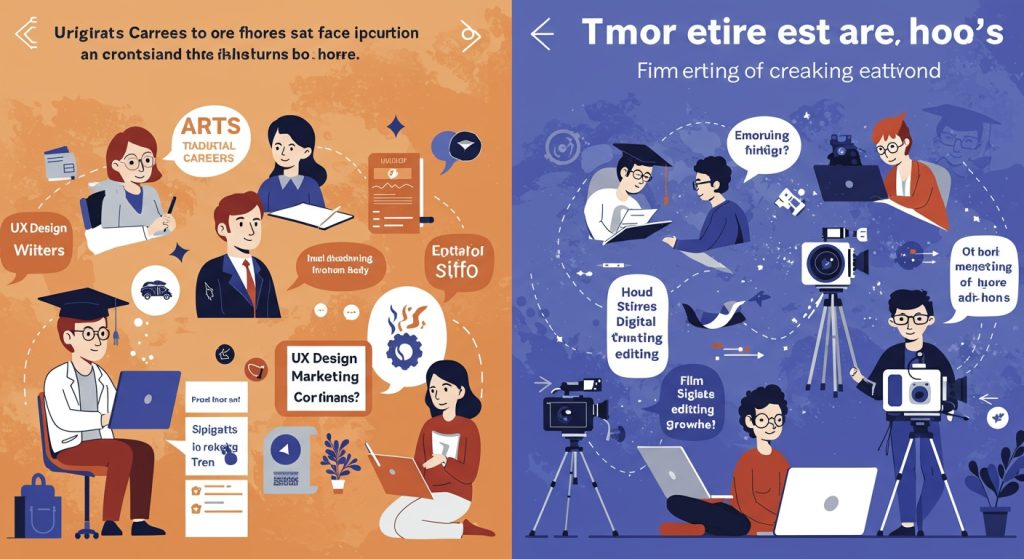The career landscape for 2025 demands more than traditional degrees; it necessitates a strategic pivot towards emerging domains. Disruptive technologies like generative AI, evidenced by its rapid integration across industries. The burgeoning bio-revolution in personalized medicine are fundamentally reshaping professional opportunities. Graduates must now consider roles like AI ethicists, digital twin engineers, or specialists in sustainable supply chain management, driven by global ESG mandates. Understanding these shifts, from the pervasive impact of quantum computing research to the critical need for robust cybersecurity protocols, empowers graduates to actively design a resilient, future-proof career path in a volatile job market.

The Rise of Ethical AI and AI Governance Specialists
As Artificial Intelligence (AI) continues its rapid integration into every facet of our lives, from healthcare diagnostics to financial algorithms, the spotlight is increasingly turning to its ethical implications and governance. For university graduates in 2025, this isn’t just a niche; it’s a burgeoning field demanding a unique blend of technical acumen, philosophical insight. Legal understanding.
Understanding AI Ethics and Governance
AI Ethics refers to the principles and moral guidelines that dictate the responsible development and deployment of AI systems. It grapples with questions like fairness (avoiding bias in algorithms), accountability (who is responsible when AI makes a mistake?) , transparency (how does an AI make decisions?). Privacy (how is user data handled?). Think of the challenges seen with facial recognition technology or AI-powered hiring tools that inadvertently discriminate.
AI Governance, on the other hand, is the practical application of these ethical principles through policies, regulations. Operational frameworks within organizations and across societies. It involves establishing rules, oversight mechanisms. Auditing processes to ensure AI systems align with societal values and legal requirements.
Key Technologies and Concepts
- Explainable AI (XAI)
- Bias Detection and Mitigation Tools
- Data Privacy Frameworks
- Algorithmic Auditing Platforms
Technologies and methods that allow human users to grasp, trust. Effectively manage AI systems. This is crucial for transparency.
Software and methodologies designed to identify and reduce inherent biases in training data or algorithmic decision-making.
Adherence to regulations like GDPR (General Data Protection Regulation) or CCPA (California Consumer Privacy Act) in the context of AI data handling.
Tools that can systematically evaluate AI systems for fairness, robustness. Compliance.
Real-World Applications and Use Cases
Consider a major bank using an AI to approve loan applications. An AI Ethics specialist would ensure the algorithm doesn’t unfairly reject applications from certain demographic groups. An AI Governance expert would then establish the internal policies for auditing this system, documenting its decision-making process. Ensuring compliance with anti-discrimination laws.
Another example is in healthcare, where AI assists in diagnosing diseases. Ensuring the AI is trained on diverse patient data (to avoid bias) and that its diagnostic reasoning is explainable to doctors (for trust and accountability) falls squarely within this domain. Leading tech companies, recognizing the imperative, are now investing heavily in dedicated AI ethics boards and roles. For instance, Google’s responsible AI principles and IBM’s push for “trusted AI” reflect this growing need.
Career Guidance for Graduates
Roles in this field include AI Ethicist, AI Policy Analyst, Responsible AI Engineer, or Data Governance Specialist. To succeed, a multidisciplinary background is highly advantageous. While a foundational understanding of AI/Machine Learning is crucial, combining it with degrees in law, philosophy, social sciences, or public policy can set you apart. Participating in hackathons focused on ethical AI, contributing to open-source projects for bias detection, or even pursuing certifications in AI governance can significantly boost your prospects. This field offers immense potential for impactful career guidance, shaping the future of technology responsibly.
Sustainable Technology and Green Engineering
As the global climate crisis intensifies, there’s an urgent demand for solutions that mitigate environmental impact and promote sustainability. This has given rise to the vibrant field of Sustainable Technology and Green Engineering, a critical area for university graduates in 2025. This domain focuses on designing, developing. Implementing technologies and processes that are environmentally responsible and resource-efficient throughout their life cycle.
What is Sustainable Technology?
Sustainable Technology, often referred to as ‘cleantech’ or ‘green tech,’ encompasses innovations that reduce negative human impact on the environment. This includes technologies for renewable energy generation, energy efficiency, waste management, pollution control, sustainable agriculture. Eco-friendly materials science.
Green Engineering is the design, commercialization. Use of processes and products that are feasible and economical while minimizing the generation of pollution at the source and the risk to human health and the environment. It’s about ‘designing for sustainability’ from the ground up, rather than just adding environmental controls at the end of a process.
Key Technologies and Concepts
- Renewable Energy Systems
- Energy Efficiency Solutions
- Circular Economy Principles
- Carbon Capture, Utilization. Storage (CCUS)
- Sustainable Materials Science
Solar (photovoltaics, concentrated solar power), wind (onshore, offshore), geothermal, hydro. Bioenergy.
Smart grids, energy storage (batteries, hydrogen), efficient building materials. Demand-side management systems.
Designing products for longevity, reuse, repair. Recycling to minimize waste and maximize resource utilization.
Technologies that capture CO2 emissions from industrial sources or the atmosphere, preventing them from entering the atmosphere.
Developing biodegradable plastics, alternative concrete. Other eco-friendly materials.
Real-World Applications and Use Cases
Imagine a smart city project where buildings are designed with integrated solar panels, rainwater harvesting systems. Smart energy management grids that optimize consumption based on real-time data. This is green engineering in action. Companies like Tesla aren’t just selling cars; they’re pushing battery storage solutions for homes and grids, embodying the energy efficiency aspect. Danish wind turbine manufacturer Vestas is a prime example of a company at the forefront of renewable energy technology.
Another compelling example is in waste management. Instead of traditional landfills, green engineers are developing advanced recycling facilities that use AI to sort waste, or bio-digesters that convert organic waste into biogas, a renewable energy source. The concept of “upcycling” – transforming discarded materials into new products of higher value – also falls under this umbrella, fostering innovative business models.
Career Guidance for Graduates
This field offers diverse career paths, including Renewable Energy Engineer, Environmental Consultant, Sustainability Analyst, Green Building Specialist. Circular Economy Strategist. A background in engineering (civil, mechanical, electrical, chemical), environmental science, material science, or even business with a sustainability focus is highly relevant. Practical experience through internships with cleantech startups, government environmental agencies, or corporate sustainability departments is invaluable. Consider certifications in LEED (Leadership in Energy and Environmental Design) for building design or pursuing postgraduate studies in renewable energy or environmental engineering. This is a field where your career guidance can directly contribute to a healthier planet.
Advanced Cybersecurity: Focusing on AI-Powered Defense and IoT Security
In our increasingly interconnected world, where every device from your smart refrigerator to industrial control systems is online, cybersecurity has become paramount. For university graduates in 2025, the demand is no longer just for traditional network defenders but for specialists adept at leveraging AI for defense and securing the sprawling Internet of Things (IoT) landscape. This is a critical area for anyone seeking impactful career guidance in a high-growth sector.
Understanding Advanced Cybersecurity
Advanced Cybersecurity in this context refers to the next generation of defensive strategies and technologies that go beyond signature-based detection. It involves proactive threat hunting, predictive analytics. Securing highly distributed and often vulnerable endpoints like IoT devices.
AI-Powered Defense utilizes machine learning and artificial intelligence to assess vast amounts of data, detect anomalies, predict potential threats. Automate responses faster than human analysts. This includes technologies like AI-driven intrusion detection systems, behavioral analytics. Automated threat intelligence platforms.
IoT Security focuses on protecting the myriad of interconnected physical devices (sensors, smart appliances, industrial machinery, medical devices) from cyber threats. These devices often have limited processing power, default credentials. Lack robust security features, making them prime targets for attackers.
Key Technologies and Concepts
- Security details and Event Management (SIEM) with AI
- Endpoint Detection and Response (EDR) & Extended Detection and Response (XDR)
- Zero Trust Architecture
- Blockchain for Security
- OT (Operational Technology) Security
Platforms that aggregate and assess security logs from various sources, using AI to identify patterns indicative of attacks.
Advanced solutions that monitor and respond to threats on endpoints (computers, mobile devices, IoT devices) using behavioral analysis and AI.
A security model that assumes no user or device, whether inside or outside an organization’s network, should be trusted by default. Every access request is authenticated and authorized.
Using distributed ledger technology to create immutable logs or secure IoT device identities.
Protecting industrial control systems (ICS), SCADA systems. Other critical infrastructure from cyberattacks.
Real-World Applications and Use Cases
Consider a large manufacturing plant equipped with thousands of IoT sensors monitoring machinery. An IoT security specialist would be responsible for segmenting these devices on the network, implementing strong authentication. Regularly patching vulnerabilities. An AI-powered defense system would continuously monitor the network traffic from these sensors, instantly flagging unusual data flows or unauthorized access attempts that could indicate a cyberattack, perhaps even before a human analyst spots it. For example, a major energy utility might use AI to detect subtle anomalies in network traffic that precede a sophisticated nation-state attack on their grid infrastructure.
Healthcare is another critical area. Hospitals are increasingly deploying IoT medical devices, from smart IV pumps to remote patient monitoring systems. Securing these devices from ransomware or data breaches is a life-or-death matter, requiring specialized IoT cybersecurity expertise. The recent rise in ransomware attacks targeting critical infrastructure underscores the urgent need for professionals in this domain.
Career Guidance for Graduates
Roles include AI Security Engineer, IoT Security Architect, Threat Hunter, Security Operations Center (SOC) Analyst (with an AI focus), or OT Security Specialist. A degree in computer science, cybersecurity, or a related engineering field is foundational. Specializing in machine learning, network security, or embedded systems can provide a significant edge. Practical skills are highly valued: gain experience with SIEM tools, penetration testing, ethical hacking. Cloud security platforms. Certifications like CompTIA Security+, Certified Ethical Hacker (CEH), or specific cloud security certifications (AWS, Azure) are excellent for enhancing your resume. This field offers dynamic career guidance with constant learning and adaptation.
Bioinformatics and Computational Biology
The intersection of biology, computer science. Statistics has given rise to Bioinformatics and Computational Biology – a rapidly expanding field poised for significant growth by 2025. For university graduates passionate about health, data. Scientific discovery, this area offers compelling opportunities to contribute to breakthroughs in medicine, agriculture. Environmental science. This is a prime area for specialized career guidance.
Defining the Fields
Bioinformatics is the application of computational tools and statistical methods to manage and examine large biological datasets. It primarily focuses on the data side of biology, such as DNA, RNA. Protein sequences, gene expression data. Molecular structures. Its goal is to extract meaningful biological insights from these vast datasets.
Computational Biology is a broader field that uses computational approaches to develop models and simulations of biological systems. While bioinformatics focuses more on data analysis, computational biology often involves creating theoretical models to grasp biological phenomena, predict outcomes, or design experiments. Think of simulating protein folding or modeling disease progression.
Key Technologies and Concepts
- Genomic Sequencing Technologies
- Big Data Analytics
- Machine Learning & AI
- Programming Languages
- Bioinformatics Databases and Tools
Next-Generation Sequencing (NGS) platforms generate massive amounts of DNA/RNA data.
Techniques for processing, storing. Analyzing terabytes of biological data, often using cloud computing platforms.
Algorithms used for pattern recognition in biological sequences, predicting protein structures, identifying disease biomarkers, or drug discovery.
Python, R, Java. Perl are commonly used for scripting, data analysis. Developing bioinformatics tools.
Accessing and utilizing public databases like NCBI GenBank, UniProt. Specialized software for sequence alignment (e. G. , BLAST), phylogenetic analysis. Structural prediction.
# Example: Basic Python snippet for reading a FASTA file (DNA sequence data)
def read_fasta(file_path): sequences = {} current_id = None with open(file_path, 'r') as f: for line in f: line = line. Strip() if line. Startswith('>'): current_id = line[1:] sequences[current_id] = "" elif current_id: sequences[current_id] += line return sequences # Usage example
# dna_data = read_fasta("my_genome. Fasta")
# print(dna_data)
Real-World Applications and Use Cases
One of the most impactful applications is in personalized medicine. By analyzing an individual’s genome (their complete set of DNA), bioinformatics can help identify predispositions to certain diseases, predict a patient’s response to specific drugs. Even tailor cancer treatments. Companies like 23andMe leverage bioinformatics to provide genetic insights to consumers, while pharmaceutical giants use it to accelerate drug discovery and development, reducing the time and cost of bringing new therapies to market.
In agriculture, bioinformatics aids in crop improvement by identifying genes responsible for traits like drought resistance or increased yield. This helps in developing more resilient and productive crops. During the COVID-19 pandemic, bioinformatics played a crucial role in tracking viral mutations, designing vaccines. Understanding disease transmission patterns, showcasing its vital role in public health.
Career Guidance for Graduates
Typical roles include Bioinformatician, Computational Biologist, Data Scientist (with a biological focus), Genomic Analyst, or Drug Discovery Scientist. A strong foundation in biology, computer science, mathematics. Statistics is essential. Many professionals in this field hold master’s or Ph. D. Degrees. Entry-level positions are available for those with strong programming skills and an understanding of biological concepts. Internships in biotech companies, research labs, or hospitals are invaluable. Learning to use common bioinformatics software packages and programming languages (Python, R) is critical. Participating in online courses or bootcamps focused on genomic data analysis can provide practical career guidance for this dynamic field.
Extended Reality (XR) Development and Design (VR/AR/MR)
Extended Reality (XR) is an umbrella term encompassing Virtual Reality (VR), Augmented Reality (AR). Mixed Reality (MR). These immersive technologies are rapidly moving beyond gaming into diverse sectors like education, healthcare, manufacturing. Retail. For university graduates in 2025, XR offers a creative and technically challenging frontier for career guidance, building the next generation of digital interaction.
Understanding XR Components
Fully immersive experiences that transport users to a simulated environment, completely replacing their real-world view. Users typically wear a VR headset (e. G. , Meta Quest, Valve Index).
Overlays digital insights onto the real world, enhancing the user’s perception of reality. This is often experienced through smartphone apps (e. G. , Pokémon Go, Snapchat filters) or AR glasses (e. G. , Microsoft HoloLens).
Blends real and virtual worlds to produce new environments and visualizations where physical and digital objects co-exist and interact in real-time. It’s more sophisticated than AR, allowing digital objects to “grasp” and react to the physical environment.
Key Technologies and Concepts
- Game Engines
- 3D Modeling and Animation Software
- XR Hardware
- Spatial Computing
- User Experience (UX) and User Interface (UI) Design for XR
Unity and Unreal Engine are industry standards for developing XR applications due to their robust 3D rendering capabilities and extensive tools.
Tools like Blender, Maya, or 3ds Max for creating digital assets (characters, environments, objects).
Understanding the capabilities and limitations of various VR headsets (tethered vs. Standalone), AR glasses. Haptic feedback devices.
The ability of a system to interpret and interact with the physical world, allowing digital content to be anchored and interact realistically within a real-world space.
Designing intuitive and comfortable interactions within 3D environments, considering factors like motion sickness and natural gestures.
// Example: Basic Unity C# script concept for AR object placement
// This isn't a full script. Illustrates the idea of
// detecting a surface and placing a virtual object. /
public class ARPlacementController : MonoBehaviour
{ public GameObject objectToPlace; // Assign your 3D model here private ARRaycastManager arRaycastManager; private List hits = new List(); void Start() { arRaycastManager = FindObjectOfType(); } void Update() { if (Input. TouchCount > 0 && Input. GetTouch(0). Phase == TouchPhase. Began) { if (arRaycastManager. Raycast(Input. GetTouch(0). Position, hits, TrackableType. PlaneWithinPolygon)) { // Raycast hit a detected plane Pose hitPose = hits[0]. Pose; Instantiate(objectToPlace, hitPose. Position, hitPose. Rotation); } } }
}
/
Comparison: VR vs. AR vs. MR
| Feature | Virtual Reality (VR) | Augmented Reality (AR) | Mixed Reality (MR) |
|---|---|---|---|
| Immersion Level | Full immersion, blocks real world | Partial immersion, overlays digital on real | Deep immersion, blends digital and real |
| Hardware | Headsets (e. G. , Meta Quest, PSVR) | Smartphones, tablets, some AR glasses | Advanced headsets (e. G. , Microsoft HoloLens, Magic Leap) |
| Interaction | Virtual controllers, hand tracking | Touch screen, basic gestures, some hand tracking | Advanced hand/eye tracking, spatial mapping, real-world object interaction |
| Primary Use Cases | Gaming, training simulations, virtual tours | Mobile apps (filters, navigation), retail previews | Industrial design, remote assistance, medical training, collaborative work |
Real-World Applications and Use Cases
In healthcare, VR is used for surgical training, allowing medical students to practice complex procedures in a risk-free environment. AR is employed by field technicians to overlay digital repair instructions onto real machinery, enhancing efficiency. For example, Porsche uses AR glasses for remote assistance, allowing experts to guide technicians on complex car repairs from afar.
Manufacturing companies use MR to design and visualize prototypes in a real-world context, reducing the need for costly physical mockups. Education is also transforming: students can explore historical sites in VR or dissect a virtual frog in AR, offering highly engaging learning experiences. The metaverse concept, while still evolving, is largely built upon XR technologies, promising new ways for people to interact, work. Socialize in persistent digital spaces.
Career Guidance for Graduates
Roles include XR Developer, 3D Artist/Modeler, XR UX/UI Designer, Simulation Engineer, or Technical Artist. A degree in computer science, game design, digital media, or graphic design is highly relevant. Strong programming skills (C#, C++), proficiency with Unity or Unreal Engine. A portfolio of 3D models or interactive experiences are crucial. Internships at XR studios, tech companies, or even university labs focusing on XR research can provide invaluable experience. Participate in game jams or hackathons to build practical skills and network. This field offers exciting career guidance for those who love to build immersive digital worlds.
Conclusion
Future-proofing your career in 2025 isn’t about predicting the exact job titles. Cultivating a mindset of adaptive learning and interdisciplinary skill acquisition. As fields like ethical AI frameworks, sustainable energy solutions. Personalized digital wellness rapidly expand, university graduates must look beyond traditional silos. For instance, understanding the societal impact of large language models, or the economic viability of green hydrogen, demands a blend of technical expertise and critical thinking. My personal tip for every graduate is to actively seek out problems, not just positions. Engage in projects that cross disciplines; volunteer for initiatives in emerging sectors. Remember, the most resilient careers aren’t built on static knowledge. On the capacity to continuously upskill and pivot. Embrace experiential learning opportunities and network relentlessly. The future isn’t waiting for you to catch up; it’s inviting you to shape it. Step forward with curiosity and an unwavering commitment to lifelong growth.
More Articles
The Future of Learning: Key Trends Shaping Public University Curricula by 2025
Beyond the Classroom: Uncovering Experiential Learning Opportunities at Public Universities
Top Undergraduate Programs: Exploring Popular Courses and Degrees at State Universities
Ensuring Quality Education: Understanding Accreditation and Standards for University Programs
Top Academic Pathways: Discovering the Best Courses for Direct University Entry
FAQs
What does ‘future-proof your career’ even mean for university graduates in 2025?
It’s all about making sure your skills and career path stay relevant and valuable in a rapidly changing job market. For 2025 grads, that means looking beyond traditional roles and understanding where true growth and innovation are happening, so you’re not left behind as industries evolve.
Why is it so vital for new grads to focus on emerging fields right now?
The job landscape is evolving super fast. By targeting emerging fields, you’re not just finding a job; you’re stepping into areas with high demand, more innovation. Better long-term growth potential. It sets you up for success from day one, rather than chasing shrinking opportunities in traditional sectors.
Can you give me some examples of these ’emerging fields’ I should be looking at?
Absolutely! Think along the lines of AI and Machine Learning ethics, sustainable technology solutions, advanced cybersecurity, personalized healthcare tech, human-AI collaboration roles. Even things like digital twin development or quantum computing applications. It’s where cutting-edge tech meets pressing societal needs.
I’m graduating soon. How can I actually get into these new areas if my degree isn’t exactly specialized in them?
Don’t worry! Your degree gives you a strong foundation. Focus on transferable skills like critical thinking, problem-solving. Adaptability. Then, look into online courses, certifications, internships, or even personal projects that bridge your existing knowledge with these new fields. Networking with professionals in these areas is also key.
Are these emerging fields only for tech majors, or can non-STEM grads find opportunities too?
Definitely not just for tech majors! Many emerging fields require a diverse range of skills. For instance, sustainable tech needs policy experts, designers. Communicators. AI ethics needs philosophers and social scientists. Personalized healthcare needs empathetic communicators and psychologists. Your unique perspective is a huge asset.
What specific skills should I be developing to thrive in these future careers?
Beyond your core degree knowledge, focus on continuous learning, data literacy (understanding and interpreting data), digital fluency, creativity, complex problem-solving. Strong interpersonal skills like collaboration and communication. Also, adaptability and resilience are non-negotiable in a dynamic environment.
When should I start exploring these options? Is it too late if I’m already in my final year?
The best time was yesterday. The second best time is right now! It’s never too late to start exploring. Even if you’re in your final year, dedicating time to research, network. Perhaps take a short online course can significantly impact your post-graduation job search. The sooner you start, the more prepared you’ll be.



